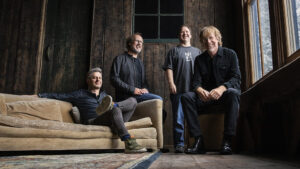In the pantheon of contemporary British art, Damien Hirst stands as both provocateur and philosopher—an artist whose works are as much about the physicality of existence as they are about the metaphysics of its limits. Among his most enduring motifs, the human skull recurs not only as memento mori but as a cultural echo, a shape caught between anatomy and eternity. “Till Death Do Us Part Skull (Green/Brown)”, created in 2012, is an electrifying iteration within this ongoing exploration—melding mortality, material, and modern visual language through silkscreen, glaze, and foil.
Framed in bright austerity against a museum-gray wall, this particular piece reveals itself in layers. From a distance, it radiates chromatic simplicity: a solitary skull suspended on a saturated green plane. But proximity reveals the nuances—a spectral interplay between image and medium, icon and interrogation.
Materiality: Silkscreen, Glaze, Foil
Hirst’s decision to combine silkscreen with glaze and foil is neither accidental nor purely aesthetic. Each medium contributes to a composite visual rhythm. The silkscreen anchors the image with its distinct boundaries—producing a print that retains both photographic precision and painterly softness. The glaze brings an almost alchemical shine to the surface, a kind of wet permanence, a paradox of preserved decay. And then there’s the foil—reflective, suggestive, cinematic—casting back not only light but implication. It shimmers differently with each step the viewer takes, implicating them in the act of viewing and subtly altering the emotional register depending on where one stands.
The green of the background is acid and surreal—unnatural yet magnetic. It denies the naturalism often associated with representations of death. This is not a graveyard green. It is synthetic. Radiant. Hyperreal. A color of digital screens and chemical reactions. It does not soothe; it insists.
The Skull: Symbol, Subject, Surface
The skull itself, printed in an oxidized brown-olive hue, hovers at the center of the composition. It feels neither anatomical nor entirely decorative—it occupies a liminal zone between object and sign. Hirst renders the skull not as relic, but as mirror: not reflective in the literal sense, but psychologically so. The absence of eyes becomes presence. The hollow jaw is a grin held in stasis.
Through foil and silkscreen layering, the skull’s features develop a chiaroscuro that is neither entirely photographic nor entirely abstract. Deep shadows pool within the eye sockets and nasal cavity, while the cranium glints with a green-gold sheen. It is haunting not because it suggests death, but because it suggests continuance after the end—a face that no longer sees, yet remains seen.
The teeth, perfectly aligned in their sinister grin, recall Hirst’s earlier works involving medicine cabinets and preserved animals. Orderliness, here, feels like a trick of control. The clean arrangement masks a deeper chaos: that of being rendered into bones.
Context Within Hirst’s Oeuvre
Hirst has long manipulated the skull motif—from his famous diamond-encrusted “For the Love of God” (2007), to the clinical arrangements of Natural History and Pharmacy series. What sets “Till Death Do Us Part” apart is its embrace of graphic clarity. Unlike his installations, which require spatial immersion, this work exists in two dimensions, which paradoxically enhances its metaphysical weight. It can be hung. Collected. Possessed. Yet it denies comfort.
The print was produced in an edition, aligning it with Hirst’s frequent engagement with mass reproduction—a recurring dialogue in his work with Warholian ideals. Indeed, “Till Death Do Us Part” resonates with the visual ethos of pop art. But where Warhol’s repetition rendered the image meaningless by saturation, Hirst preserves the skull’s charge. Even in duplication, it pulses with singularity.
Reading the Title: “Till Death Do Us Part”
The phrase itself—“Till Death Do Us Part”—drips with cultural resonance. It is most familiar as part of matrimonial vows, a romantic pledge wrapped around a fatal promise. By binding the skull to this phrase, Hirst executes a dark twist: what was once a vow of unity becomes a confrontation with separateness. Death, here, is not the great unifier—it is the great divider.
Yet there’s irony too. The skull—detached from context, from identity, from warmth—is now framed, signed, limited, commodified. The art market “marries” it to its buyer. In owning the image of death, one participates in its deferral—perhaps not in life, but in meaning.
Color Theory & Contrast
The green background in this iteration is especially potent. It operates as both chromatic foil and conceptual field. In color theory, green is often associated with growth, nature, and fertility—the very antithesis of a skull. This juxtaposition creates visual tension. The eye doesn’t quite know where to settle. It is pushed and pulled between vibrancy and decay. The skull seems to float, like a warning embedded in a warning label.
This tension is emphasized by the brownish hue of the skull itself. It does not shimmer with ornament—it sinks. The foil glints selectively, but the color reads as rust, as oxidization, as something that has been buried, unearthed, and made to speak again.
Frame as Architecture
Hirst’s choice of white framing is another act of control. It disciplines the image. It gives it boundaries. Against the bright green, the white mount functions like negative space—offering the viewer a visual pause, a kind of breathing room between the explosive energy of the print and the wall’s neutrality.
The frame, substantial and deliberate, also plays into Hirst’s aesthetic of medical or forensic distance. It is the glass panel on the specimen jar. The vitrification of thought. The coffin, perhaps.
Presence, Reproduction, and the Art of the Multiple
As part of a limited edition series, “Till Death Do Us Part” challenges the fetishization of the one-of-one artwork. In creating multiple versions, each rendered in slightly different color palettes, Hirst offers death as both uniform and unique. Every skull is the same. Every skull is different. The viewer cannot unsee this contradiction.
Moreover, the silkscreen process—historically associated with mass media, posters, and activism—is repurposed here to elevate and disturb. It democratizes and deifies the subject in one stroke. This is death not just as biological event, but as media object, ready for broadcast, collection, consumption.
Ideologue
Damien Hirst’s “Till Death Do Us Part Skull (Green/Brown)” is more than an artwork—it is a ritual in pigment and print, a gesture that balances between reverence and revolt. Through its tactile complexity, symbolic precision, and haunting restraint, the piece holds a mirror up to mortality and dares the viewer not to look away.
It challenges us to consider what it means to own death, to look upon it every day and call it art. It suggests that even in repetition, the image of the end never dulls. That there is no color so bright it can silence the whisper of the skull. That until death does part us, we will keep searching its surface for answers.
No comments yet.








